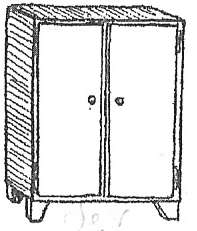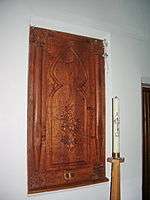Cupboard
The term cupboard was originally used to describe an open-shelved side table for displaying dishware, more specifically plates, cups and saucers. These open cupboards typically had between one and three display tiers, and at the time, a drawer or multiple drawers fitted to them. The word cupboard gradually came to mean a closed piece of furniture.[1][2]

Types of cupboards
Airing cupboard
An airing cupboard is a built-in storage space, sometimes of walk-in dimensions, containing a water heater, either an immersion heater for hot running water or a boiler for central heating water (hence, also "boiler cupboard"), or a hot water storage tank. Shelves, usually slatted to allow for circulation of heat, are positioned above or around the heater to provide room for clothing. The purpose is to allow air to circulate around the stored fabrics to prevent damp forming.
Some variants of airing cupboards also serve as the linen cupboard, the storing area of the household's clean sheets and towels.
In another version, the airing cupboard serves as a temporary drying space, either for laundry or for wet outdoor clothes and shoes. Its shelves can be used to fully remove traces of damp from dried clothing before the items are put away elsewhere in drawers and wardrobes. A moveable electrical version of this is a drying cabinet.
Built-in cupboard
A built-in cupboard is a storage space that forms part of the design of the room and is not free-standing or moveable. It is not the same as a cabinet. In the United Kingdom houses often have a built-in cupboard under the stairs.
Linen cupboard
A linen cupboard is an enclosed recess of a room used for storing household linen (e.g. sheets, towels, tablecloths) and other things for storage, usually with shelves, or a free-standing piece of furniture for this purpose.[3]
Stationery cupboard
Most offices have a lockable repository for valuables. The heart of this is usually the supply of stationery.
Gallery
 Built-in cupboard: A cupboard built into the wall of St James's Church, Whitechapel, Lancashire
Built-in cupboard: A cupboard built into the wall of St James's Church, Whitechapel, Lancashire Stationery cupboard: An office stationery cupboard, with its lockable doors open
Stationery cupboard: An office stationery cupboard, with its lockable doors open- Antique cupboard: English livery cupboard approximately 1600 to 1640
- Antique cupboard: Decorative crockery and bibelots in vitré armoire or vitrina
See also
References
| Wikimedia Commons has media related to cupboards. |
| Look up cupboard in Wiktionary, the free dictionary. |
- "Cupboard". The Free Dictionary By Farlex. Retrieved 19 May 2012.
- Andrews, John (2006) British Antique Furniture. Antique Collectors' Club ISBN 1-85149-444-8; p. 226
- Bravery, Suzanne (10 May 2008), "The Linen Cupboard", Mother's Day Address at Eryldene, Gordon, NSW: Eryldene Trust, retrieved 30 March 2009